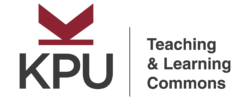What is it? The jigsaw activity is a co-operative learning activity where students “divide and conquer” to learn about different aspects of a topic. First, they are assigned to a small group focusing on a specific subtopic. All students who are assigned that subtopic do some reading and discuss it, asking for clarification if needed. […]
The Lightboard Studio on Langley campus. What is it? The lightboard is a tool to make videos where you can face the audience and interact with your writing/drawings in real time. The instructor faces the camera and stands behind a glass board which they write on normally. The video is then flipped so that the […]
What is it? Kahoot! is a service which allows people to make online quizzes which learners can join from their mobile devices or computers. It’s quite popular in secondary education. You can play a demo game to learn about Kahoot. It could be used for an in-class pre-quiz or review activity. Students could also make […]
What is it? H5P allows instructors to embed interactive elements into their Moodle sites. Some examples include: A full list of all H5P objects can be found at H5P’s website. What are the benefits? H5P adds an interactive active learning element to what might otherwise be passive forms of learning: reading a book or watching […]
What is it? Traditional assessments, such as written exams, are often held up in opposition to authentic assessments, which align more closely with skills that graduates would be expected to demonstrate in the working world. A video assessment can take many forms: students could record and narrate their solution to a problem (Allain, 2017); record […]
What is it? Padlet is best thought of as a digital equivalent of an online bulletin board. It is a versatile tool for education. Not only can students make posts and comments, but they can also attach documents, images, and recordings (audio or video). In August 2023, Padlet added the ability to include a multiple […]
What is it? Exam wrappers are exam-adjacent activities that are intended to promote student reflection on their learning processes and improve their metacognition. Exam wrappers can be administered before and/or after a test. Typical questions on an exam wrapper might be: What strategies did you use to prepare for the test? How effective were those […]
What is it? Final exams in STEM subjects are often completely written. However, such assessments do not always align with learning outcomes that involve higher-order skills such as experimental design. An oral exam gives students a chance to demonstrate their mastery of the material and a simulation of professional practice. What are the benefits? When […]
What is it? The course presentation, or syllabus, is meant to encapsulate the information that a student needs to be successful in a course: what topics will be covered, how their learning will be assessed, how to get help… But students don’t always take the time to read the syllabus. Kenyon Wilson of the University […]
What is it? Concept inventories can be used as a pre-test, to assess prior student knowledge, and as a post-test, to measure learning in a course. They are typically research-based, multiple-choice assessments which have been developed in fields such as physics and astronomy, biology, chemistry, and mathematics. What are the benefits? When used as pre-tests, […]

